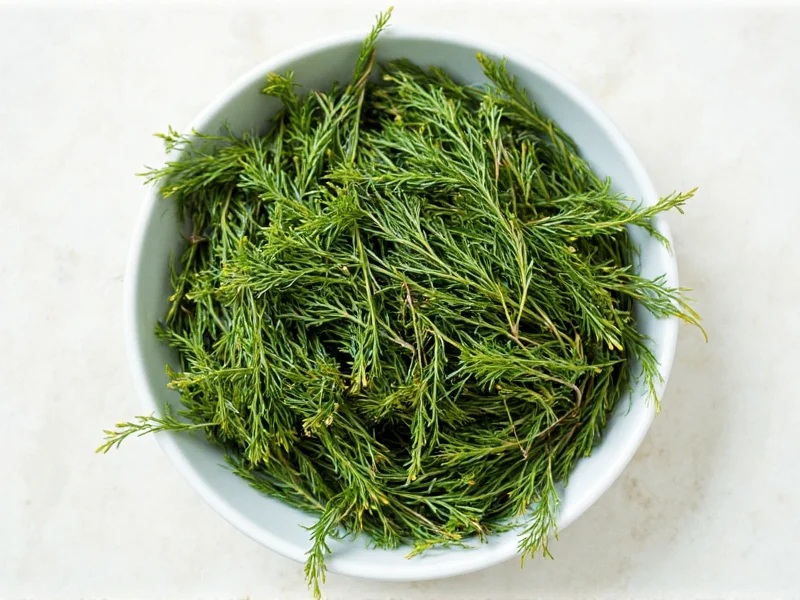When you're in the middle of cooking and realize your recipe calls for fresh dill but you only have dried dill in your pantry, knowing the proper substitution ratio is crucial for maintaining flavor balance. The 1:3 ratio (dried to fresh) isn't arbitrary—it reflects how the drying process concentrates the essential oils and flavors in herbs. Dried dill has lost its water content, making its flavor more potent by volume than fresh dill.
Understanding Dill Substitution Science
Dill weed contains volatile oils that provide its distinctive flavor and aroma. When dill is dried, approximately 80-90% of its water content evaporates, leaving behind a more concentrated form of these flavor compounds. This concentration explains why you need less dried dill to achieve a similar flavor intensity as fresh.
Professional chefs and food scientists consistently recommend the 1:3 ratio as the starting point for substitution. However, several factors can influence how this ratio works in your specific recipe:
| Substitution Ratio Guide | Fresh Dill Amount | Dried Dill Equivalent |
|---|---|---|
| Basic substitution | 1 tablespoon | 1 teaspoon |
| Delicate dishes (fish, salads) | 1 tablespoon | ¾ teaspoon |
| Robust dishes (stews, pickling) | 1 tablespoon | 1¼ teaspoons |
| Long-cooking recipes | 1 tablespoon | Add in two stages: ½ tsp early, ½ tsp at end |
Flavor Profile Differences to Consider
While the 1:3 ratio provides a good starting point, understanding the flavor differences between dried and fresh dill is essential for perfect substitution. Fresh dill offers bright, grassy notes with citrus undertones and a subtle anise-like quality. Dried dill maintains the core flavor profile but loses some of the delicate top notes, resulting in a more earthy, concentrated taste.
When substituting dried for fresh dill, keep these flavor considerations in mind:
- Dried dill lacks the bright, fresh aroma of its unprocessed counterpart
- The citrus notes become less pronounced in dried form
- Dried dill develops slightly more earthy, woody characteristics
- The intensity of flavor compounds changes during drying
Best Practices for Substituting Dried Dill
For optimal results when replacing fresh dill with dried, follow these professional cooking techniques:
Timing Matters
Add dried dill early in the cooking process for dishes with long simmer times (like soups, stews, or pickling brines). The extended cooking allows the dried herb to rehydrate and release its flavors gradually. For quick-cooking dishes or finishing touches, add dried dill during the last 10-15 minutes of cooking to preserve more of its volatile flavor compounds.
Rehydration Technique
For recipes where fresh dill would typically be added at the end (like salads or cold dishes), try this chef-recommended technique: mix your measured dried dill with 1-2 teaspoons of warm water or lemon juice and let it sit for 5-10 minutes before adding to your dish. This partially rehydrates the herb, creating a flavor profile closer to fresh dill.
Adjusting for Dish Type
Not all recipes respond equally to dill substitution. Consider these guidelines when determining how to adjust your dried dill measurements:
- Fish and seafood dishes: Use slightly less dried dill (reduce by 25%) as seafood has delicate flavors that can be overwhelmed
- Pickling recipes: Maintain the full 1:3 ratio as the vinegar environment extracts flavor differently
- Cold dishes and salads: Consider using ⅔ of the standard substitution amount and add just before serving
- Baked goods: Increase dried dill by 25% as baking can diminish herb flavors
When Substitution Isn't Recommended
While dried dill can effectively replace fresh in many applications, certain recipes truly require fresh dill for authentic results. Consider these situations where substitution may compromise your dish:
- Dill-focused dishes like Scandinavian gravlax or Polish ogórków kiszonych (fermented cucumbers)
- Raw applications where the texture of fresh dill matters, such as on top of finished dishes
- Recipes specifically developed for fresh dill's unique moisture content
- Dishes where the visual appeal of fresh dill fronds is important
Storage Impact on Substitution Accuracy
The age and storage conditions of your dried dill significantly affect its potency and, consequently, your substitution accuracy. Properly stored dried dill (in an airtight container away from light and heat) maintains optimal flavor for 1-2 years. After this period, its potency diminishes, requiring slight adjustments to your substitution ratio.
Test your dried dill's freshness by rubbing a small amount between your fingers and smelling it. If the aroma is weak or musty, increase your measurement by 25-50% to compensate for flavor loss. Freshly dried dill (within 6 months) may require using slightly less than the standard ratio.
Common Substitution Mistakes to Avoid
Even with the correct ratio, many home cooks make these common errors when substituting dried dill for fresh:
- Adding dried dill too late: Unlike fresh dill, dried needs time to rehydrate and release flavors
- Not adjusting for recipe acidity: Acidic ingredients (like vinegar or lemon) can intensify dried herb flavors
- Using the same measurement by volume for all herbs: Different herbs have different concentration factors (dill's 1:3 ratio differs from basil's 1:4 ratio)
- Not tasting and adjusting: Always taste your dish after adding dried herbs and adjust as needed











 浙公网安备
33010002000092号
浙公网安备
33010002000092号 浙B2-20120091-4
浙B2-20120091-4